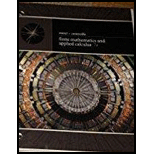
Concept explainers
Day Trading Day traders typically buy and sell stocks (or other investment instruments) during the trading day and sell all investments by the end of the day. Exercises 63 and 64 are based on the following table, which shows the closing prices on September 22, 2015, of 12 stocks selected by your broker, Prudence Swift, as well as the change that day.22
| Tech Stocks | Close | Change |
| AAPL (Apple) | $113.40 | –1.81 |
| ADBE (Adobe Systems) | $84.66 | 1.34 |
| EBAY (eBay) | $25.61 | –0.31 |
| MSFT (Microsoft) | $3.90 | –0.21 |
| S (Sprint) | $4.40 | 0.02 |
| WIFI (Boingo Wireless) | $8.51 | 0.56 |
| Non-Tech Stocks | ||
| ANF (Abercrombie & Fitch | $21.81 | –0.02 |
| B (Boeing) | $133.99 | –2.03 |
| F (Ford Motor Co.) | $13.91 | –0.40 |
| GE (General Electric) | $25.10 | 0.01 |
| GIS (General Mills) | $57.12 | 0.33 |
| JNJ (Johnson & Johnson) | $93.26 | 0.13 |
On the morning of September 22, 2015, Swift advised your friend to purchase a collection of three stocks chosen at random from those listed in the table. Your friend was to sell all the stocks at the end of the trading day.
a. How many possible collections are possible?
b. How many of the collections in part (a) included exactly two tech stocks that increased in value by the end of the day?
c. Using the answers to parts (a) and (b), what would you say the chances were that your friend chose a collection that included exactly two tech stocks that increased in value by the end of the day?
Want to see the full answer?
Check out a sample textbook solution
Chapter 7 Solutions
Finite Mathematics and Application Calculus (Looseleaf) - Text Only
- Find the distance from the point (-9, -3, 0) to the line ä(t) = (−4, 1, −1)t + (0, 1, −3) .arrow_forward1 Find a vector parallel to the line defined by the parametric equations (x(t) = -2t y(t) == 1- 9t z(t) = -1-t Additionally, find a point on the line.arrow_forwardFind the (perpendicular) distance from the line given by the parametric equations (x(t) = 5+9t y(t) = 7t = 2-9t z(t) to the point (-1, 1, −3).arrow_forward
- Let ä(t) = (3,-2,-5)t + (7,−1, 2) and (u) = (5,0, 3)u + (−3,−9,3). Find the acute angle (in degrees) between the lines:arrow_forwardA tank initially contains 50 gal of pure water. Brine containing 3 lb of salt per gallon enters the tank at 2 gal/min, and the (perfectly mixed) solution leaves the tank at 3 gal/min. Thus, the tank is empty after exactly 50 min. (a) Find the amount of salt in the tank after t minutes. (b) What is the maximum amount of salt ever in the tank?arrow_forwardpleasd dont use chat gptarrow_forward
- Draw the vertical and horizontal asymptotes. Then plot the intercepts (if any), and plot at least one point on each side of each vertical asymptote.arrow_forwardDraw the asymptotes (if there are any). Then plot two points on each piece of the graph.arrow_forwardCancel Done RESET Suppose that R(x) is a polynomial of degree 7 whose coefficients are real numbers. Also, suppose that R(x) has the following zeros. -1-4i, -3i, 5+i Answer the following. (a) Find another zero of R(x). ☐ | | | | |│ | | | -1 བ ¢ Live Adjust Filters Croparrow_forward

 Trigonometry (MindTap Course List)TrigonometryISBN:9781337278461Author:Ron LarsonPublisher:Cengage Learning
Trigonometry (MindTap Course List)TrigonometryISBN:9781337278461Author:Ron LarsonPublisher:Cengage Learning Glencoe Algebra 1, Student Edition, 9780079039897...AlgebraISBN:9780079039897Author:CarterPublisher:McGraw Hill
Glencoe Algebra 1, Student Edition, 9780079039897...AlgebraISBN:9780079039897Author:CarterPublisher:McGraw Hill Holt Mcdougal Larson Pre-algebra: Student Edition...AlgebraISBN:9780547587776Author:HOLT MCDOUGALPublisher:HOLT MCDOUGAL
Holt Mcdougal Larson Pre-algebra: Student Edition...AlgebraISBN:9780547587776Author:HOLT MCDOUGALPublisher:HOLT MCDOUGAL



